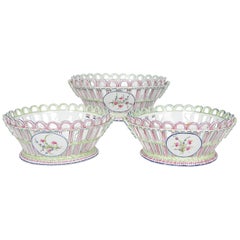Jean Louis Beyerle
Recent Sales
Antique Early 19th Century French Rococo Decorative Baskets
Porcelain
A Close Look at rococo Furniture
Rococo was an aesthetic movement in the fine and decorative arts in the 18th century that found its inspiration in nature and fostered an overall lightness and delicacy of form, construction and ornament in interior design. Rococo furniture, while greatly influenced by trends in Italy and Germany, is often called Louis XV style — the movement having reached its best expression during that sybaritic French king’s reign.
The term “rococo” is thought to be a portmanteau of the French words rocaille and coquilles — “rock” and “shells” — organic motifs frequently used in architecture and design of the style.
When it comes to authentic Rococo furniture's characteristics, it is above all sensuous and social. The furniture of earlier eras in Europe had been heavy in every sense; the Rococo period saw the appearance of light-framed upholstered armchairs, side chairs and occasional tables that could easily be moved to form conversational circles.
The signal detail of Rococo furniture design is the gently curved cabriole, or S-shaped chair-, table-, and cabinet-leg. It imitates the bend of a tree limb or a flower stem. In a further reference to nature, furnishings were often asymmetrical and painted white, or in soft, pastel shades. Rococo has become a timeless style, and as the furniture pieces presented on 1stDibs demonstrate, its playful, sculptural forms can provide visual excitement to contemporary, clean-lined spaces.
Finding the Right decorative-baskets for You
Antique and vintage decorative baskets can lend unique charm to any room. And basketmaking is hardly a lost art.
Evidence of basket weaving dates back tens of thousands of years, with one of the most intact examples found in the Judean Desert from the Neolithic period. Historically, baskets have mainly served utilitarian needs — to carry food, store materials and even hold water — but they could also be ornamental objects or have ceremonial or religious purposes.
Native American baskets come from a tradition steeped in generations of skill. There are new and made-to-order baskets from artisans who put their own spin on the ancient art as well as 21st-century pre-owned decorative baskets to complement any furniture style or design preference.
A metal basket or brass basket can match a modern or industrial-style home and add some contrasting rusticity. Wooden baskets, wicker baskets and natural-fiber baskets can easily harmonize with boho chic and cottagecore interiors.
Ceramic baskets are part of the pottery tradition, a craft with a deep heritage in human history. Ceramics are popular in decor again, and the personalization of handmade craftsmanship has served as a sort of anti-Internet to screen-weary decorators. Depending on a ceramic basket’s style, it can fit in with a more formal, cottage, Asian or Southwestern interior theme.
Browse 1stDibs for a wide selection of decorative baskets to fit any design need.
